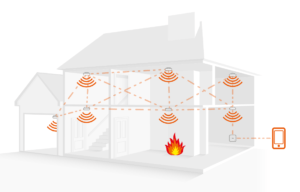As the latest COVID-19 restrictions continue to present health and safety professionals throughout the social housing sector with a myriad of additional and ever changing challenges that must be addressed, advancements in IoT and AI technology are not only helping to overcome these issues, but also provide a revolutionary approach to the proficient management and maintenance of housing portfolios.
 Here Ian Ballinger, Head of Projects and Certification at FireAngel, explores the benefits of following the principles of the Draft Building Safety Bill by procuring connected fire safety technologies that successfully future-proof an entire housing portfolio through the facilitation of a ‘Golden thread’ of digital building information that is accessible in real time by all necessary individuals.
Here Ian Ballinger, Head of Projects and Certification at FireAngel, explores the benefits of following the principles of the Draft Building Safety Bill by procuring connected fire safety technologies that successfully future-proof an entire housing portfolio through the facilitation of a ‘Golden thread’ of digital building information that is accessible in real time by all necessary individuals.
The findings of the Hackitt Report, combined with the guidance outlined in the Draft Building Safety Bill, continue to drive significant changes throughout the industry with regard to how fire safety compliance should be approached and achieved across each social housing stock.
Fire and safety regulations
At the forefront of these changes is providers’ approaches to achieving and maintaining adherence with fire safety regulations. This not only focuses on current regulations, but outlines the importance and necessity of successfully future proofing every property across an entire portfolio from further legislative updates.
This proactive attitude, which goes above and beyond duty of care, also ensures each tenant’s individual level of risk is not only identified and understood, but allows actionable measures to be implemented to deliver the highest standards of safety.
This is achievable through the creation of a ‘Golden thread’ of building information, which is updated in real time in response to changes to property or tenant behaviour throughout the entire lifecycle of the building. As this data can be remotely accessed at all times by the relevant individuals, it further supports the principles of the Draft Building Safety Bill as a constant stream of communication is stored and shared on a central secure network. This also achieves full traceability, demonstrating practicable compliance throughout every stage of the building and management processes.
Stratification of risk
 However, in order to successfully achieve this, professionals must first be able to identify the occupancy profile and vulnerability of residents in order to effectively create a stratification of risk that enables assets to be implemented in the most efficient way.
However, in order to successfully achieve this, professionals must first be able to identify the occupancy profile and vulnerability of residents in order to effectively create a stratification of risk that enables assets to be implemented in the most efficient way.
This is accomplished through the procurement and installation of connected fire safety technologies, which utilise Smart RF and Predict technology to provide remote real time monitoring of every alarm in each property across an entire network. The wireless interlinking of smoke, heat, carbon monoxide alarms and a secure cloud-based connected gateway delivers essential information regarding each alarm, and most importantly, identifies the level of risk each property presents.
This includes information such as full alarm history, network health, current status and replacement dates. It also undertakes silent network testing automatically every 18 hours for each property, creating a digital trail of compliance, whilst also ensuring the positive status and performance of every alarm.
While connected technologies that facilitate remote monitoring across an entire network are key to ensuring social housing providers achieve the ‘Golden thread’ of building information, they are also presenting the answer to some of the greatest problems being faced by the sector due to COVID-19.
Connected technologies
 With a high proportion of tenants potentially representing the most vulnerable groups of society, the necessary restrictions being enforced to maintain their safety and wellbeing by mitigating the possible spread of the virus has had a substantial effect on how professionals manage their tenants and the status of their properties.
With a high proportion of tenants potentially representing the most vulnerable groups of society, the necessary restrictions being enforced to maintain their safety and wellbeing by mitigating the possible spread of the virus has had a substantial effect on how professionals manage their tenants and the status of their properties.
Here connected technologies that utilise predict technology combined with IoT and AI are providing social housing providers with cost effective and efficient methods of overcoming these issues, as the requirement to gain physical access to a property in order to understand the level of risk is eliminated. This also supports the long term reduction of overheads associated with missed appointments or failing to gain access to a property.
With regard to legislation, the differing guidelines outlined within Approved Document B (Fire Safety) volume 1 and the recent revision of Part 6 of BS 5839 share varying recommendations on the minimum requirement of fire safety for social housing.
Through the specification of Smart RF compatible systems, providers can ensure each property is compliant with an LD1 Category specification, whilst also offering the ability to be upgraded and adapted at a later date to incorporate additional safety elements that protect against each tenant’s individual level of risk.
Highest standards of affordable living
By choosing systems that facilitate integration with wider smart home devices through an open protocol, providers can also ensure each property can regularly be enhanced to deliver the highest standards of affordable living, which can be tailored to each tenant’s level of risk.
This constant source of remote real time monitoring also works to overcome the requirement for a waking watch within buildings that currently require it while the increased level of risk is being addressed, as any changes in alarm status, or the activation of an alarm, is recorded instantly through the gateway, notifying the relevant individuals.
With 2020 presenting the industry with some of the greatest challenges to date, health and safety professionals have the opportunity to completely revolutionise their approach to asset management through the provision and installation of connected technologies that provide remote real time monitoring to support the principles outlined in both the Hackitt Report and Draft Building Safety Bill through a ‘Golden thread’ of information that is continuously updated.
Fire Safety in 2023 eBook
SHP's sister site, IFSEC Insider has released its annual Fire Safety Report for 2023, keeping you up to date with the biggest news and prosecution stories from around the industry.
Chapters include important updates such as the Fire Safety (England) Regulations 2022 and an overview of the new British Standard for the digital management of fire safety information.
Plus, explore the growing risks of lithium-ion battery fires and hear from experts in disability evacuation and social housing.

 Here Ian Ballinger, Head of Projects and Certification at FireAngel, explores the benefits of following the principles of the Draft Building Safety Bill by procuring connected fire safety technologies that successfully future-proof an entire housing portfolio through the facilitation of a ‘Golden thread’ of digital building information that is accessible in real time by all necessary individuals.
Here Ian Ballinger, Head of Projects and Certification at FireAngel, explores the benefits of following the principles of the Draft Building Safety Bill by procuring connected fire safety technologies that successfully future-proof an entire housing portfolio through the facilitation of a ‘Golden thread’ of digital building information that is accessible in real time by all necessary individuals.  However, in order to successfully achieve this, professionals must first be able to identify the occupancy profile and vulnerability of residents in order to effectively create a stratification of risk that enables assets to be implemented in the most efficient way.
However, in order to successfully achieve this, professionals must first be able to identify the occupancy profile and vulnerability of residents in order to effectively create a stratification of risk that enables assets to be implemented in the most efficient way. With a high proportion of tenants potentially representing the most vulnerable groups of society, the necessary restrictions being enforced to maintain their safety and wellbeing by mitigating the possible spread of the virus has had a substantial effect on how professionals manage their tenants and the status of their properties.
With a high proportion of tenants potentially representing the most vulnerable groups of society, the necessary restrictions being enforced to maintain their safety and wellbeing by mitigating the possible spread of the virus has had a substantial effect on how professionals manage their tenants and the status of their properties.